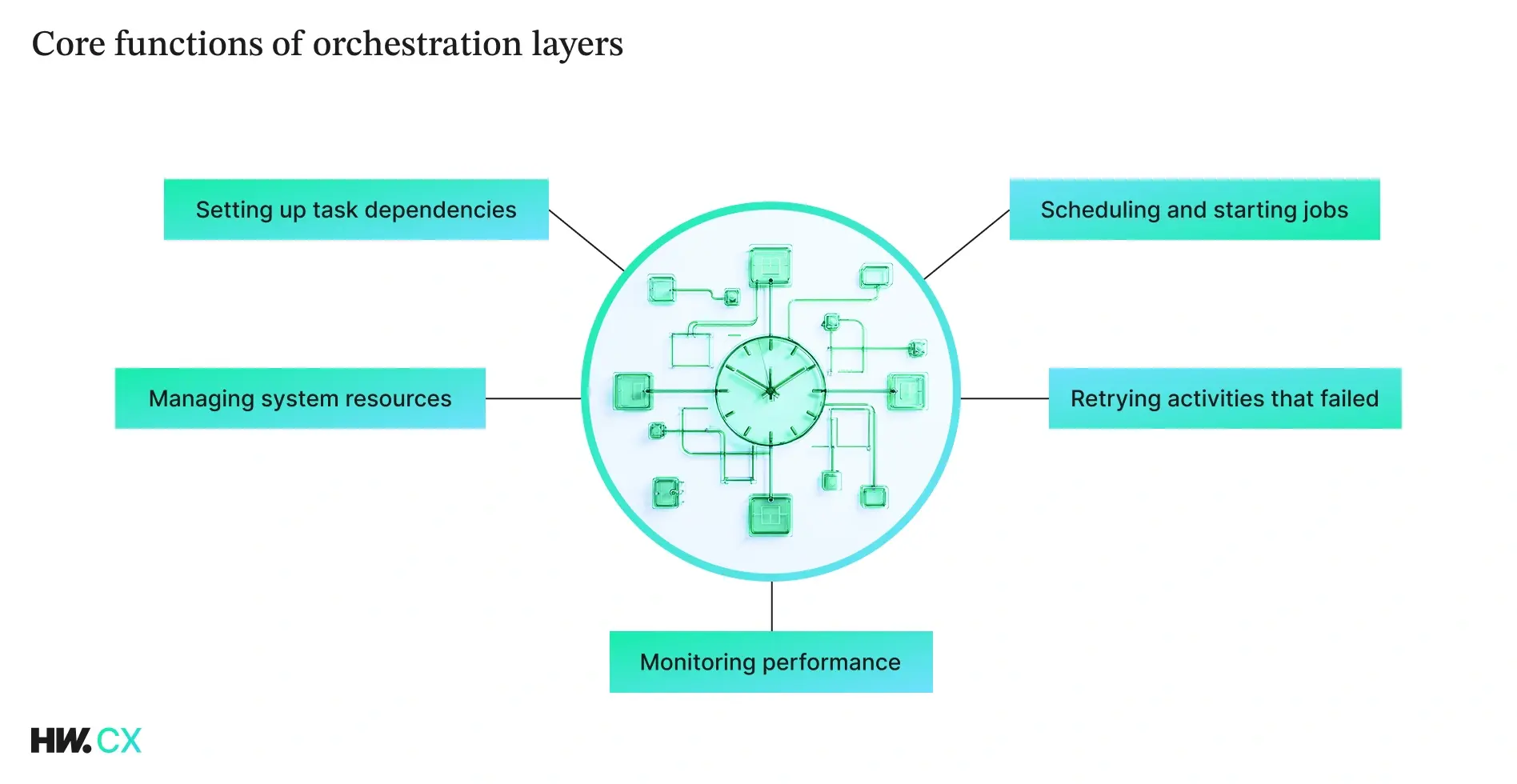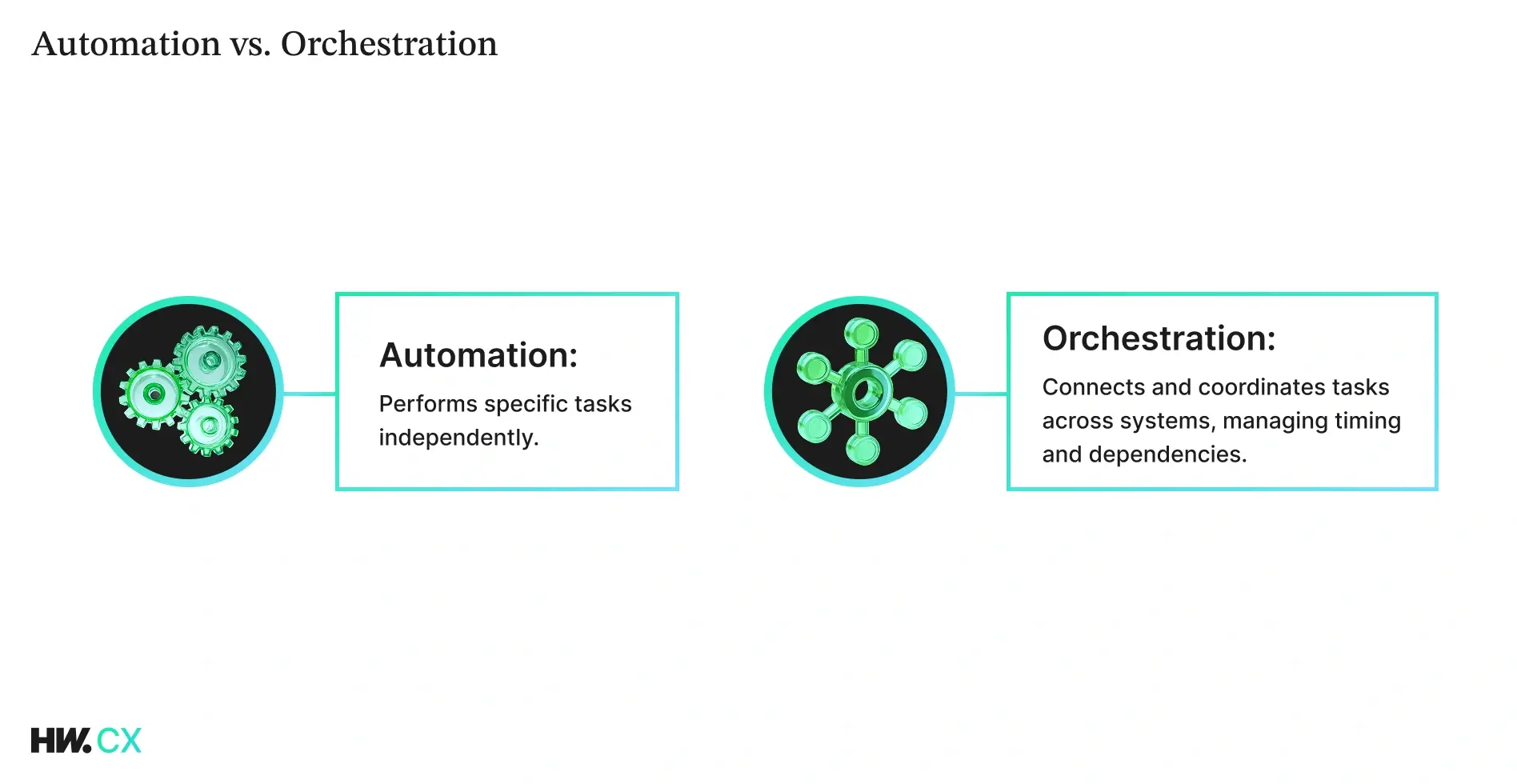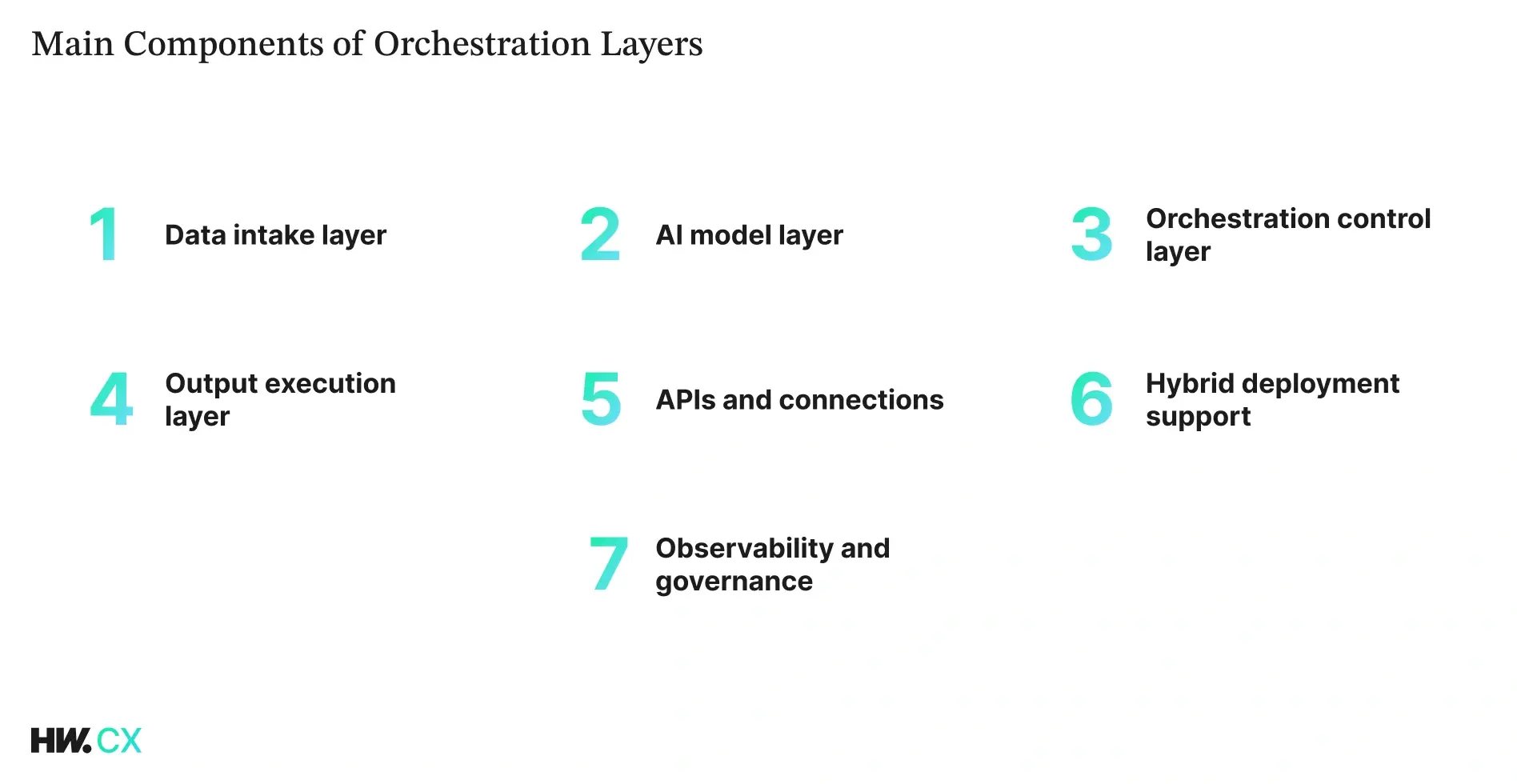In today’s businesses, hybrid AI and human operations are omnipresent. Chatbots for customer support work with live agents, bots that process invoices send tricky instances to finance personnel, and AI assistants help HR departments screen job applicants. Things that look smooth on paper often turn out to be a mess in real life. Disconnected systems, manual hand-offs, and data silos slow things down and make processes less efficient. More and more, businesses are realizing that orchestration layers—software parts that manage humans, AI models, and computing resources—are necessary to get the most out of hybrid processes.
The trend is clear with Clarifai’s compute orchestration platform, which allows businesses to use any model on any infrastructure with serverless autoscaling, cutting down on latency and costs. This article goes over the main problems with hybrid AI + human workflows, defines what orchestration layers are, and shows how they change customer service and back-office labor. At each step, we’ll use what we’ve learned from top CX experts and AI practitioners and show how Clarifai is different from the rest.
Hybrid AI and Human Workflows: Realities and Examples
AI-driven automation and human oversight work together in hybrid processes. A virtual agent handles simple questions in contact centers, but a human agent takes over when things get complicated, emotional, or unclear. A recent Talkdesk study says that customer support agents are “the lifeblood of contact centers”; AI should handle boring chores so that agents spend more time on valuable encounters.
In fact, 79% of those who work in customer service think that AI would provide human agents with new tools instead of taking their jobs. The human-in-the-loop (HITL) method ensures that AI systems keep learning. When a chatbot gets the wrong idea, agents fix the model and send the new data back through the training pipeline.
Back-Office Workflows: Beyond Customer Service
Customer service isn’t the only place where hybrid work happens. Robotic process automation (RPA) bots handle bills and update records in back-office areas like finance, HR, and IT, but people check the outputs when the confidence scores drop below certain levels. AIMultiple’s research shows that many IT, HR, and finance operations are repetitive and take a lot of time, and RPA can cut costs by 40%.
Workload-automation technologies that schedule, trigger, and monitor workflows from a central location work well with RPA, improving data management and compliance. Machine-learning models using picture recognition and natural language processing handle unstructured documents, while supervised models find problems in financial data. These instances show why coordination is so important: when AI and people work alone, mistakes happen more often, escalations take longer, and compliance risks rise.
How Can Organizations Balance AI and Humans?
Moira Withrow, the VP of Operations for a major BPO, compares hybrid CX to driving a car: “AI is the engine, and people are the ones who drive it.” The engine gives power and efficiency, but the driver makes sure the trip goes smoothly, safely, and is right for the destination. AI takes care of the mechanics, and people take care of the magic. This balance is essential when designing a hybrid workflow.
Where Hybrid Workflows Fail: Current Challenges
Even while hybrid workflows sound good, they often fail because systems aren’t integrated and data is kept in silos. Document360 says that data silos are “separations in communication and data access”, leading to data duplication, inconsistency, and outdated information, which wastes storage space and slows down work. When teams pass off projects without a shared context, they “feel under-prepared or clueless,” a sign of bad communication pipelines. Manual hand-offs make the situation worse. In customer support, these gaps appear as bot loops that can’t answer complicated inquiries or agents who can’t see chat history, forcing customers to repeat themselves.
In addition, compliance and security become problems when AI and human workflows aren’t coordinated. Finance bots that update bills without audit trails may not follow the rules, while HR bots that handle personal data without consent restrictions may leak private information. Genesys says that linking data silos is necessary to improve the experiences of both customers and employees. Without unified supervision, different bots or agents may not work together, causing delays in escalations, uneven customer experiences, and higher operating costs.
What Are Orchestration Layers?
An orchestration layer is a piece of software that controls how multiple systems work together. AI21 Labs says that orchestration layers automate workflows by starting tasks on connected tools, which is especially useful when working with huge language models. Integration lets data move between systems, but orchestration “enhances it by shaping how processes unfold and how each system responds.” Developers set rules that decide when tasks start and how components interact, so operations run in a controlled order without manual coordination.

Automation vs. Orchestration: What’s the Difference?
It’s critical to understand the difference between automation and orchestration if you want to design efficient workflows. Automation refers to individual tasks that run automatically, such as sending notifications, updating a record, or processing a transaction. Orchestration, on the other hand, sits above automation: it coordinates how these tasks interact across multiple systems, determining the sequence, timing, and dependencies to ensure the entire process runs smoothly. While automation handles the “what,” orchestration manages the “how” and “when,” connecting separate operations into a cohesive, reliable workflow.

Pure Storage says that an orchestration layer is a middleman between APIs, containers, virtual machines, and other parts. It automates complicated operations and ensures that all the different parts work together smoothly. Orchestration automates provisioning, scaling, and administration of resources in cloud environments using hybrid or multi-cloud setups.
How Do Orchestration Layers Support AI/LLM Workflows?
AI21’s study shows that orchestration layers are great for AI/LLM workflows because they handle multi-step tasks, including preparing data, running prompts, checking results, and formatting output. Kubernetes and Apache Airflow are examples of the orchestration pattern. Clarifai’s compute orchestration takes this idea further and applies it to generative AI and multimodal models.
Transforming Customer Service with Orchestration Layers
Orchestration layers in contact centers ensure that AI agents such as chatbots and call transcription engines work smoothly with human agents. When confidence drops or sentiment analysis shows frustration, a single control plane automatically moves interactions from bot to agent. According to the Broadvoice blog, Human-in-the-Loop (HITL) is about collaboration, not competition—people keep an eye on things, step in when needed, and help the AI learn better. This balance keeps empathy and nuance alive while AI provides power and efficiency.
Key benefits of orchestration for customer service include:
- Continuous learning: HITL sends data back with each human intervention, making AI more accurate.
- Seamless integration: Orchestration links CRMs, knowledge bases, and phone systems, enabling chatbots to update CRM records in real time.
- Elastic scaling: When traffic spikes, orchestration starts elastic computing to keep latency low.
- Deployment flexibility: Clarifai’s compute orchestration lets you deploy any model on any infrastructure with serverless autoscaling. It handles containerization, model packing, and time slicing.
- Cost savings: You can create several compute clusters optimized for different workloads, automatically scale from zero to infinity, and avoid vendor lock-in. Optimizations like GPU fractioning and model packing can save 60–90% on costs. Clarifai CEO Matt Zeiler notes that a Compute Orchestration Layer can cut compute expenses by up to 90%.
Why Orchestration Matters in Back-Office Operations
Back-office functions—finance, HR, IT, and supply chain—include many repetitive, rule-based jobs. Orchestration layers can transform these by:
- Automating repetitive tasks: RPA bots handle accounts payable and receivable, payroll, and record keeping.
- Centralizing workflow management: Workload-automation technologies schedule and monitor workflows from one place, improving compliance.
- Handling unstructured data: Image recognition and computer vision automate documents for unstructured data like invoices and reports.
- Integrating NLP and machine learning: Chatbots assist with tasks like booking leave requests; machine-learning models spot anomalies in ledgers and contracts.
When technologies operate in isolation, errors multiply and delays creep in. That’s where orchestration layers come in. They connect people, processes, and systems to ensure AI workflows are accurate, compliant, and efficient.
An effective orchestration layer can:
- Route low-confidence documents to human reviewers.
- Record and learn from human decisions to improve accuracy over time.
- Update models continuously to reduce recurring errors.
- Ensure compliance and transparency by integrating with ERP and document management systems.
- Support flexible deployment, whether on-premises, across multiple sites, or in a self-managed VPC — with nodepools and compute clusters providing the right CPU/GPU mix for regional needs.
- Optimize resource use through auto-scaling and intelligent scheduling, eliminating waste while enabling continuous batching and inference streaming.
Architecture and Main Components of Orchestration Layers
In distributed systems, numerous layers interact to execute jobs, allocate resources, and handle errors. The orchestration layer is the backbone of this ecosystem, ensuring that dependencies are respected, workloads are balanced, and performance is continuously monitored. An effective orchestration layer includes several main components:
- Data intake layer: Gets data from CRM systems, document repositories, and call transcripts, changing it into a standard format. Pure Storage notes that orchestration helps with data transformation and server management.
- AI model layer: Stores models for natural language processing, OCR, recommendations, or anomaly detection. Clarifai’s compute orchestration lets users deploy any model on any infrastructure, managing containerization and dependencies.
- Orchestration control layer: Sets workflow logic, plans tasks, and manages resources. AI21 notes that orchestration layers set up task dependencies and triggers, allocate resources, and handle retries. Clarifai’s control plane enables auto-scaling and GPU time-slicing for optimal performance.
- Output execution layer: Sends results back to users or downstream systems, updating CRM records, providing notifications, or starting human involvement. Logs and status updates improve visibility. Clarifai’s compute clusters and nodepools allow control over where and how hardware is set up to ensure low latency.
- APIs and connections: Link the orchestration layer to telephony systems, ERPs, and cloud storage. Genesys and Document360 highlight the need to connect data silos and unify platforms.
- Hybrid deployment support: Works with cloud, on-premises, and edge environments. Clarifai can be set up as shared serverless, dedicated SaaS, self-managed VPC, on-premises, or multi-site—providing flexibility for security and regulatory needs.
- Observability and governance: Provide dashboards, logs, and metrics to monitor performance, costs, and compliance. AI21’s orchestration layer checks performance and logs, while Clarifai’s control plane allows granular access governance.

Experts in data platforms note that orchestration layers make it possible for different systems to share data seamlessly, improving resource use and automating complex procedures. Modularity and observability are crucial when designing orchestration structures for future AI-driven workloads.
Best Practices for Implementing Orchestration Layers
AI orchestration doesn’t imply deploying technology only; the main idea is to properly structure workflows, seamlessly integrate systems, and ensure the right balance between automation and human oversight. The following best practices outline how to implement orchestration effectively and sustainably.
Start with high-priority workflows
Identify processes where coordination problems cause delays or poor customer experiences. Contact center escalations and invoice approvals are common starting points. The Broadvoice article suggests reviewing current procedures to find where AI works best and where human intervention is required.
Use API-based integration
Connect CRMs, ERPs, and HR systems via APIs to avoid new silos. Genesys underscores that linking data silos is the best way to achieve end-to-end experiences.
Phase your rollout
Start with one department, gather feedback, and then expand. HITL isn’t a one-time setup; monitor performance indicators and continually gather agent feedback.
Prioritize observability and monitoring
Build dashboards that show workflow status, latency, and expenses. AI21 highlights the importance of logs and status updates for troubleshooting and performance improvement.
Leverage open-source AI models and compute orchestration
Deploy models quickly with container orchestration tools like Kubernetes. Clarifai’s compute orchestration lets you run models in your own VPC or on-premises with nodepools that auto-scale and save money.
Ensure security and compliance
Implement fine-grained access controls, encryption, and audit logs. Clarifai allows compute planes to be run in customer-controlled environments, protecting sensitive data.
Train and empower your team
Educate agents and back-office workers on AI tools. IT Brief reports that empathy and adaptability are lacking, yet are often underfunded skills. Teach staff when to intervene, how to give feedback to AI models, and how to interpret orchestration metrics. Broadvoice emphasizes training agents in soft skills like empathy and adaptability, enabling them to become AI trainers and connection builders.
The Future of Hybrid Workflows: What Comes Next
Hybrid AI and human operations are here to stay, but without orchestration, they can become chaotic. Data silos, manual hand-offs, and disconnected tools cause inefficiencies and hazards. Orchestration layers fill the missing control plane by defining workflows, scheduling tasks, managing resources, and ensuring visibility. Clarifai’s compute orchestration shows how serverless autoscaling, nodepools, and modular deployment options can be used to deploy any model on any infrastructure, potentially saving up to 90% on costs.
In customer service, orchestration ensures that AI chatbots, transcription engines, and live agents work together to deliver personalized, caring experiences. In back-office operations, it coordinates RPA bots, OCR models, and human verifiers, allowing staff to focus on exceptions and compliance. Looking ahead, there may be agentic AI ecosystems where orchestration layers coordinate many specialized agents and compute orchestration hides hardware complexities. Companies that embrace orchestration will not only control the turmoil of hybrid workflows but also gain greater flexibility, efficiency, and customer satisfaction.











